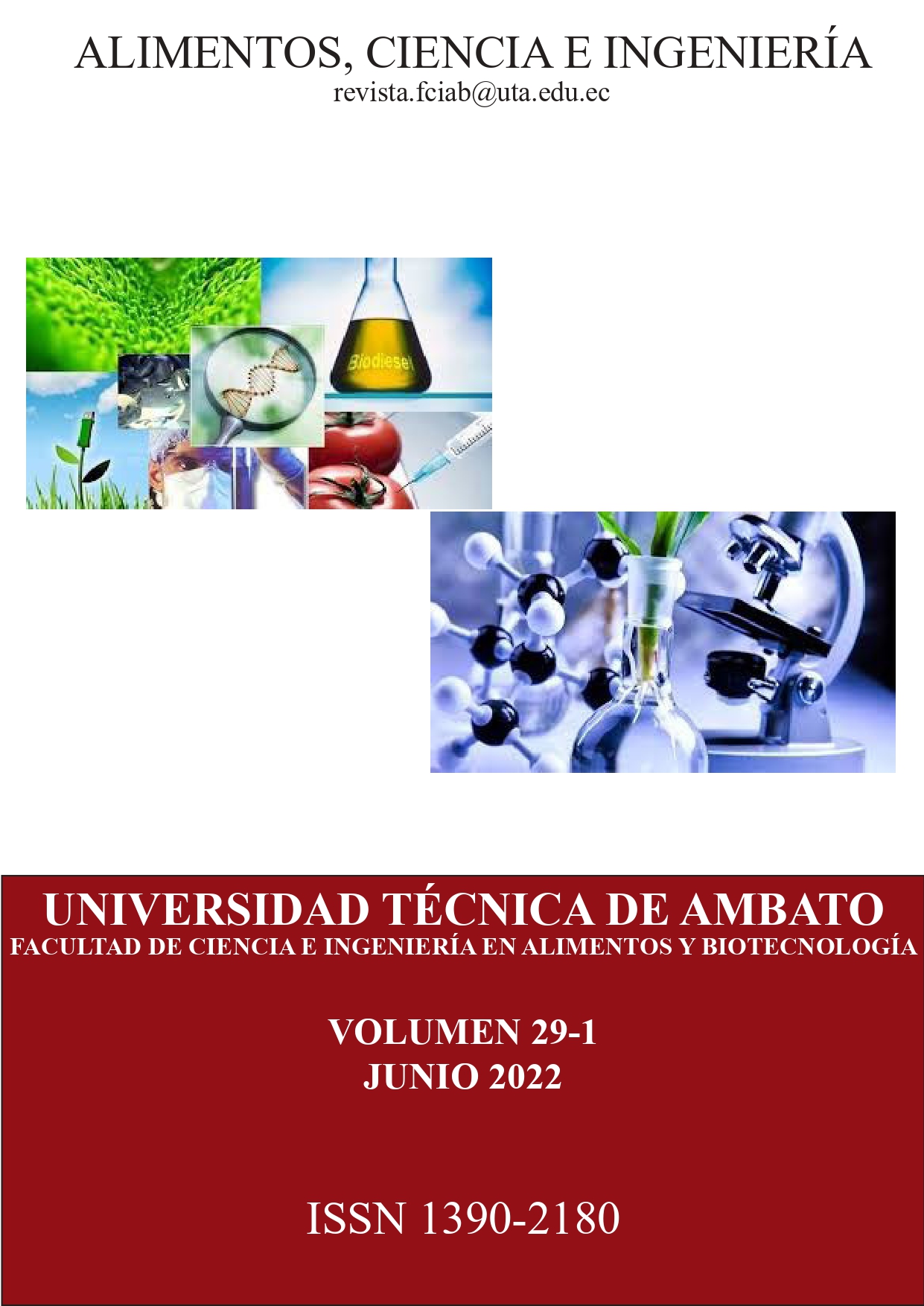Efecto de concentraciones de miel de abeja en la producción de una conserva en almíbar con fruta de pitahayas (Hylocereus undatus) y (Cereus ocampis)
Contenido principal del artículo
Resumen
El objetivo principal de la investigación fue evaluar el efecto de tres concentraciones de miel de abeja en la producción de una conserva en almíbar con fruta de pitahayas (Hylocereus undatus) y (Cereus ocampis). Se utilizó un Diseño Completamente al Azar con arreglo factorial AxB. Para la comparación de promedios de los tratamientos se utilizó la prueba de TUKEY al (p<0,05) de acuerdo a los resultados del ANOVA (pH y °Brix), para el análisis sensorial se aplicó una estadística no paramétrica utilizando la prueba de Kruskal Wallis y la comparación de promedios (en los casos de significancia estadísticamente) mediante el test de U Mann-Whitney. Los resultados del pH de las conserva de pitahayas indicaron que existió significancia estadística al (p< 0,05); obteniendo valores de pH en un rango de 4,55 a 4,96 y en los °Brix finales no existió significancia estadística. Se midió la estabilidad del almíbar de la miel de abeja donde el tratamiento A1B1 y A1B3 alcanzaron su estabilidad a los 28 días obteniendo 14,2 y 18,1° Brix finales. Los tratamientos A1B2, A2B1, A2B2 y A2B3 se llevaron 30 días en alcanzar la estabilidad de los sólidos solubles con resultados de 18,1, 14,7, 18,1 y 22,1°Brix. En el análisis organoléptico existió significancia al (p< 0,05) para el atributo olor y textura, y con respecto al sabor, color y apariencia fue no significativo. Los análisis microbiológicos realizados al producto de mayor aceptación tuvieron valores aceptables dentro de los parámetros que estipula la Norma INEN 1529. Se obtuvo efecto favorable con el uso de miel de abeja en el almíbar porque ayudó a mantener mejor las conservas de pitahaya gracias a sus propiedades conservantes.
Descargas
Detalles del artículo

Esta obra está bajo una licencia internacional Creative Commons Atribución-NoComercial 4.0.
Aquellos autores/as que tengan publicaciones con esta revista, aceptan los términos siguientes:
a. Los autores/as conservarán sus derechos de copiar y redistribuir el material, bajo los términos estipulados en la Licencia de reconocimiento, no comercial que permite a terceros compartir la obra bajo las siguientes condiciones:
Atribución: debe dar el crédito apropiado, proporcionar un enlace a la licencia e indicar si se realizaron cambios. Puede hacerlo de cualquier manera razonable, pero no de ninguna manera que sugiera que el licenciante lo respalda a usted o su uso.
No comercial: no puede utilizar el material con fines comerciales.
Sin restricciones adicionales: no puede aplicar términos legales ni medidas tecnológicas que restrinjan legalmente a otros hacer cualquier cosa que la licencia permita.
Citas
Adams, M. y Moss, M. (2008). Food Microbiology. Cambridge: The Royal Society of Chemistry.
Álvarez-Suárez, J., Tulipani, S., Díaz, D., Estévez, Y., Romandini, S., Giampieri, F., Damián, E., Astolfi, P., Bompadre, S. y Battino, M. (2010a). “Antioxidant and antimicrobial capacity of several monofloral Cuban honeys and their correlation with color, polyphenol content and other chemical compounds”. Food Chem. Toxicol. 48: 2490-2499.
Álvarez Suárez, J.M., Tulipani, S., Romandini, S., Bertoli, E. y Battino, M. (2010b). “Contribution of honey in nutrition and human health: a review”. Mediterr. J. Nutr. Metab. 3: 15-23.
Antony, S., Rieck, J.R. y Dawson, P.L. (2000). “Effect of dry honey on oxidation in turkey breast meat”. Poultry Science 79: 1846-1850.
Alzamora, S.M., Tapia, M.S. y Welti-Chanes, J. (2004). Nuevas estrategias por procesamiento mínimo de los alimentos: El rol objetivo de la preservación. Ciencia y tecnología de alimentos internacional 4.
Castro, E. (2017). Efecto antibacteriano de miel de Apis mellífera y algarrobina de Prosopis pallida sobre coliformes en quesillos preparados artesanalmente expendidos en el mercado “La Unión”.
Codex Alimentarious. (2001). Norma para la miel de abeja (en línea). Disponible en: http://www.codexalimentarius.net/search/advancedsearch.do
Codex Alimentarius. (2013). Norma para algunas frutas en conserva.
Chen, L., Mehta, A., Berenbaum, M., Zangerl, A.R. y Engeseth, N.J. (2000). “Honeys from different floral sources as inhibitors of enzymatic browning in fruit and vegetable homogenates”. J. Agric. Food Chem. 48: 4997-5000.
Dawson, P.L. y Mathew, S. (2000). “Antioxidative properties of honey in poultry meat”. Summary of a research project funded by the National Honey Board (NHB) and conducted at Clemson University. Available from NHB (www.nhb.org).
FAO. (2007). Buenas prácticas para la producción a pequeña escala de agua de coco embotella: Grados °Brix. Italia. Ro. p 9.
Johnston, J.E., Sepe, H.A., Miano, C.L., Brannan, R.G. y Alderton, A.L. (2005). “Honeys inhibit lipid oxidation in ready-to-eat ground beef patties”. Meat Sci. 70: 627- 631.
McKibben, J. y Engeseth, N.J. (2002). “Honey as a protective agent against lipid oxidation in ground turkey”. J. Agric. Food Chem. 50: 592-595.
Mondragón, P., Rodríguez, R., Renséndiz, J., Ulloa, P., y Ulloa, J. (2010). La miel de abeja y su importancia. Obtenido de https://www.researchgate.net/profile/Rogelio_Rodriguez_Rodriguez/publication/29982 1229_La_miel_de_abeja_y_su_importancia/links/5705c2ff08aef745f717702a/La-miel- de-abeja-y-su-importancia.pdf.
Montesinos, J., Rodríguez, L., Ortiz, R., Fonseca, M., Ruiz, G., & Guevara, F. (2015). Obtenido de INCA: http://scielo.sld.cu/pdf/ctr/v36s1/ctr07s115.pdf.
Murillo, G. (2004). Ficha técnica de industrialización de frutas en conserva. Obtenido de https://es.scribd.com/doc252272651/Ficha-Técnica-de-Industrializacion- de-Frutas-en-Conserva.
Norma INEN 2760. (2013). Norma para conserva de frutas y vegetales. Ecuador.
Oré, L. (2007). Tesis de grado “Evaluación del tratamiento térmico en conserva mixta de papaya (Carica papaya L) y cocona (Solanum topiro) en envases de hojalata”. Universidad Nacional Agraria de la Selva. Perú.
Sotomayor, E. (2018). Tesis de Grado. Desarrollo de mango (Mangifera indica L.) en almíbar a base de miel de abeja y Stevia. Universidad Católica de Santiago de Guayaquil..
Willix, D.J., Molan, P.C. y Harfoot, C.G. (1992). “A comparison of the sensitivity of wound-infecting species of bacteria to the antibacterial activity of manuka honey and other honey”. Journal of Applied Bacteriology 73: 388-39


